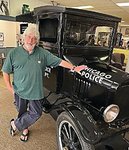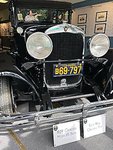


It’s the Roaring ’20s reborn, complete with “The Untouchables” – Eliot Ness and his T-men who cracked down on gangsters in Chicago – and it’s in a small town in Pennsylvania.
For years my husband and I have been driving the more than 250 miles to the north central part of the state to visit his brother.
The route from Bucks to Potter County is cushioned with trees – and trees – and more trees, with sweeping green mountains rearing on all sides.
Coudersport, the county seat, is a handsome little town caught between the Allegheny River and the white pine and hemlock forests of the Allegheny Mountains.
The harvesting of those trees turned it into a boomtown in the 1880s and 1890s when the lumber industry reigned. Proudly ornate Victorian buildings lining its streets reflect its long-ago prosperity. Its handsome Courthouse Square dominates the historic district and logging trucks still pass through town.
Occupied with family matters, we usually just passed through town too, but on this last visit we had a chance to explore, and came upon, of all things, the Eliot Ness Museum.
“Why Coudersport?” I asked myself. “Why not Chicago where Ness and his ‘Untouchables’ fought organized crime and police corruption in the 1920s and sent Al Capone to prison? Or Cleveland, a city Ness, as public safety director, made squeaky clean a decade later?
The answer is simple. Because Ness spent his final years in that little town where he owned a watermark business he hoped would put an end to forgery. While his crime-fighting abilities were supreme, his business acumen was not, and his choice of partners was unfortunate. He died there in 1957 of a heart attack at the age of 54.
It was in Coudersport where he met Oscar Fraley, a reporter whose work was heavy on overstatement and drama, and together they turned Ness’s story into a book called “The Untouchables.”
An ABC television series starring Robert Stack as Ness and Walter Winchell as narrator ran from 1959 to 1963, and in 1967 Kevin Cosner played the crime-buster in a movie. Now, the Eliot Ness Museum is revealing the true story of the man who squashed the bootleggers, corrupt cops and money-grubbing politicians during Prohibition.
As Special Agent for the Treasury Department, this famous lawman, soft-spoken and seemingly fearless, had an aversion to firearms. He rarely carried a gun but was known to wear an empty shoulder holster occasionally.
Join our readers whose generous donations are making it possible for you to read our news coverage. Help keep local journalism alive and our community strong. Donate today.